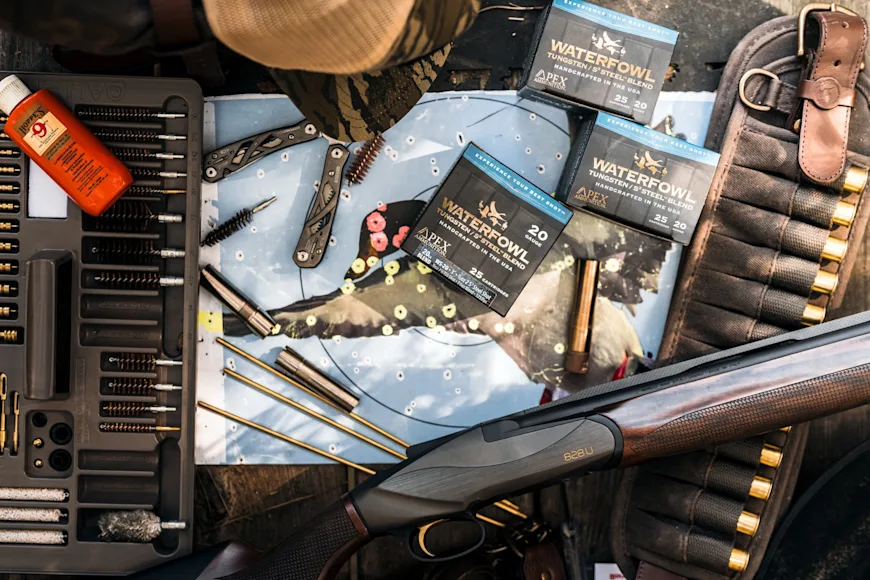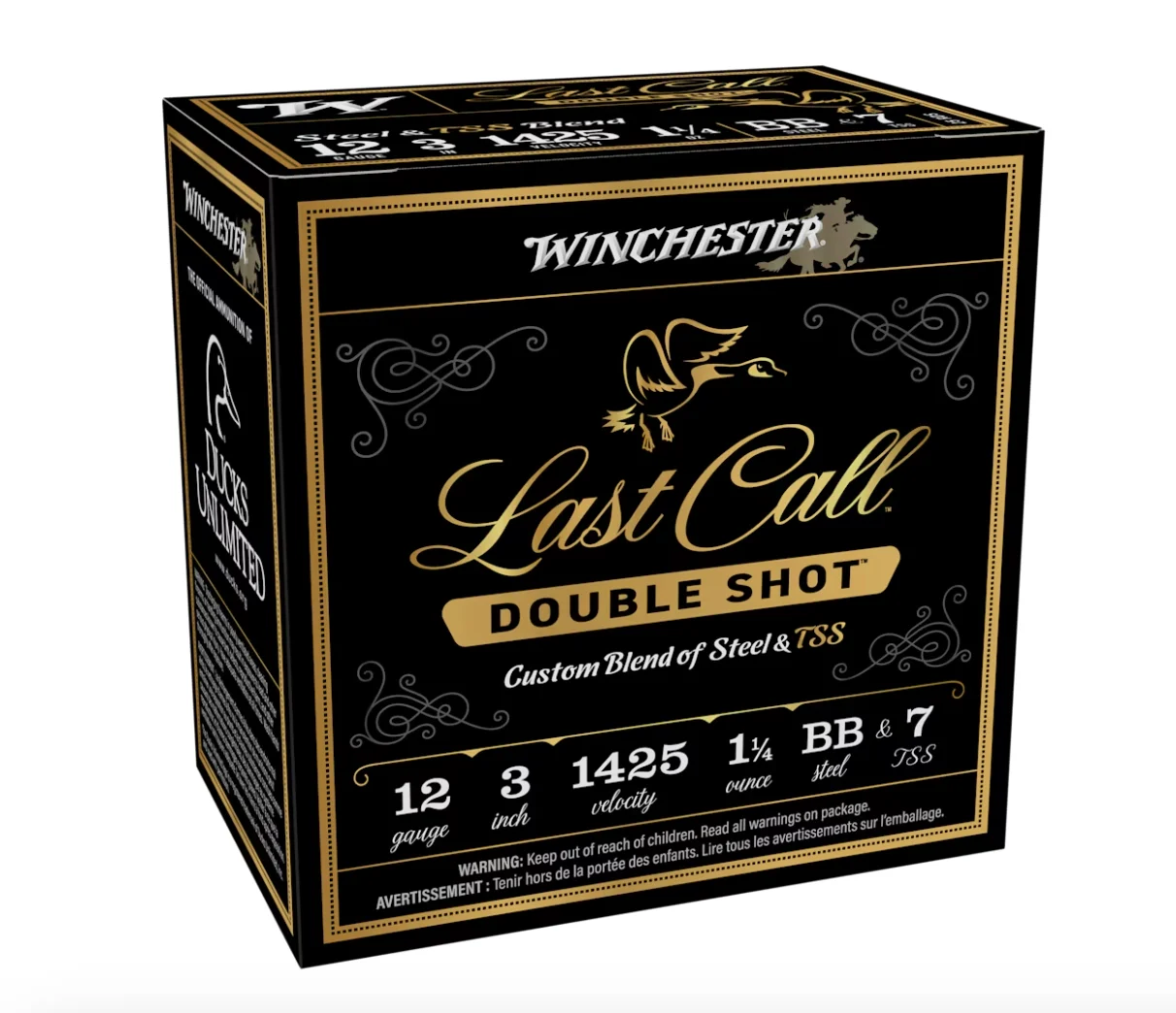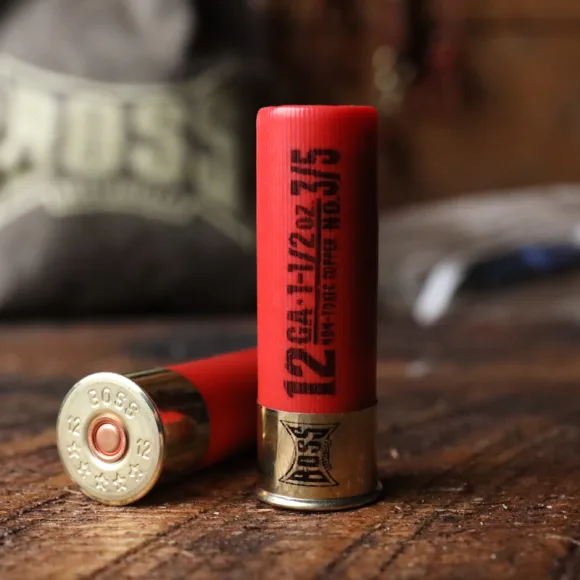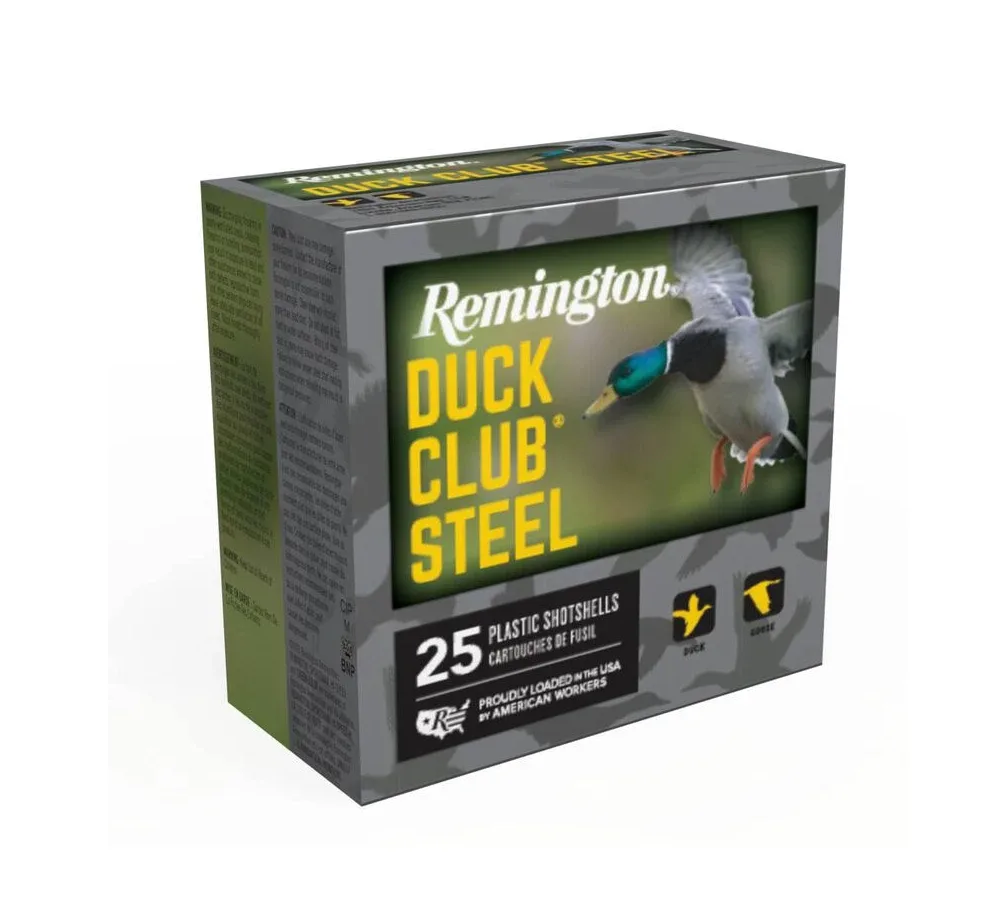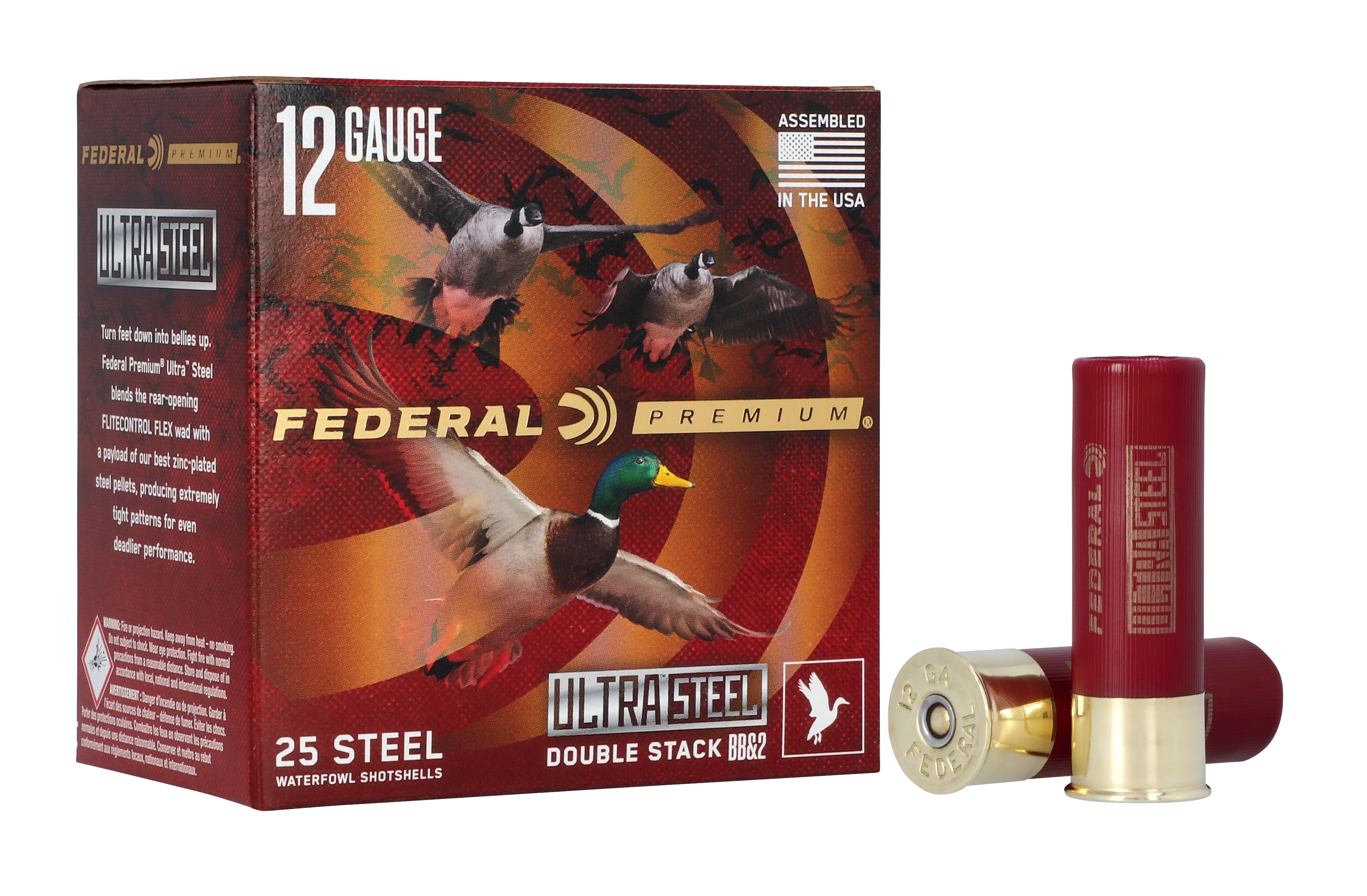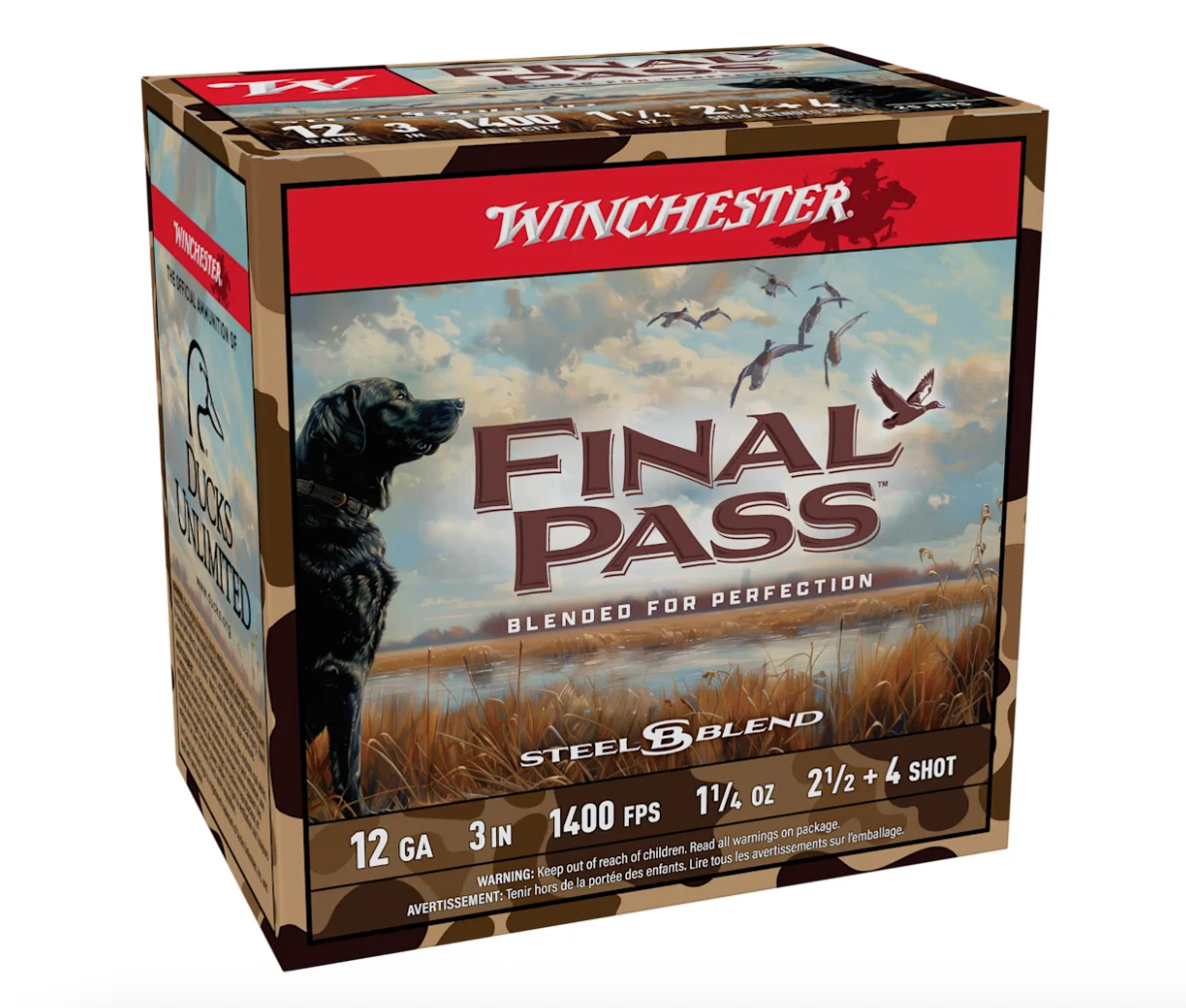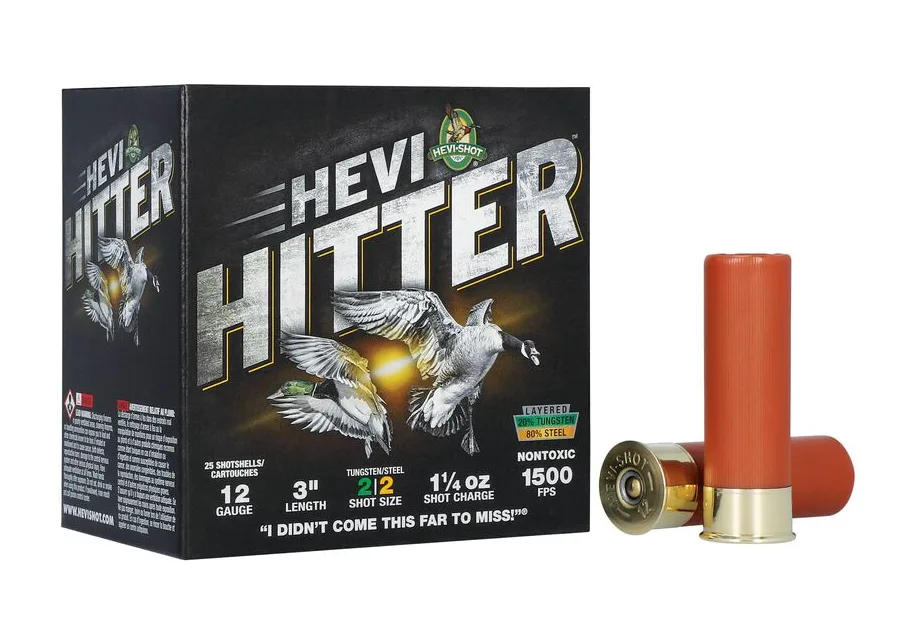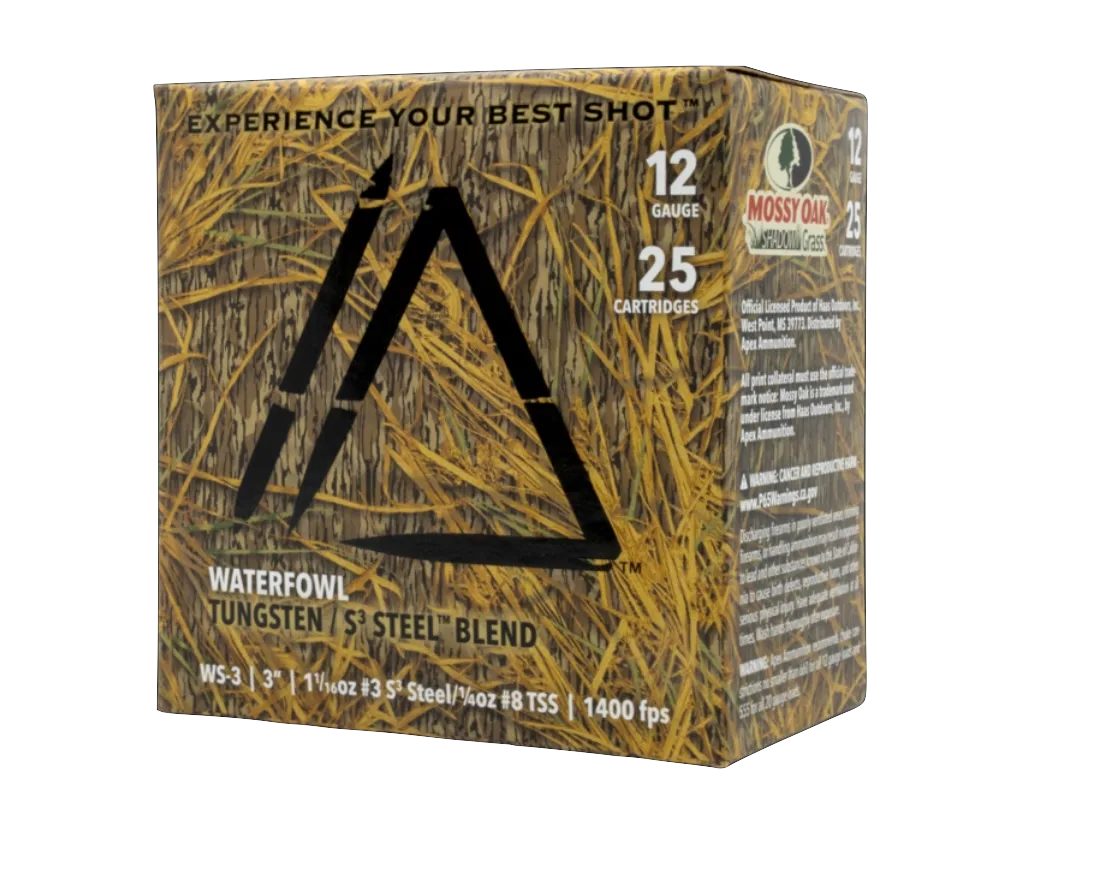If bismuth and tungsten have been the recent trends in non-toxic pellet materials, steel and copper may be the pellets of the future. Some of that steel may be loaded with a bit of TSS, but we have to face the fact that bismuth and tungsten prices are rising out of control, and that China contains 80 to 90 percent of the world’s supply of both metals. Tungsten and bismuth have applications far beyond making pellets to shoot ducks and geese with, and global demand is up. That leaves us with steel, and potentially, with corrosion-inhibited copper.
Copper shot is the exciting new development for 2025. Boss is the first to offer corrosion-inhibited copper shot to the US market. Denser than steel, it will offer more energy than steel shot, although not as much energy as bismuth does. It is harder than bismuth, but soft enough to be safe in older guns. It’s not cheap, at around $2 per shell, but the price of premium steel is high, too.
Speaking of steel, mixed loads—some are stacked, some are not—continue to set the trend in non-toxic ammo. It’s getting hard to find shells containing all one size of shot. Stacked loads of two different sizes of steel are a gimmick. Stacked loads of two different sizes of steel work. Both can be true at the same time, and they are.
The shells I patterned this year, most of which were of mixed shot size, patterned very efficiently, and they seemed to place a good mix of big and small shot in the right parts of the pattern. So do shells containing one size of steel, although I only received one to test this year: Remington’s budget Duck Club. After shooting it, I’d be happy to hunt with that any time and save money.
Mixed loads of premium pellets and steel continue to be a trend, and I am becoming a believer. We have the ammunition for a good season. Here's a closer look at all of the best new duck loads available today.
Best Premium: Winchester Last Call Double Shot
Most Innovative: Boss Copper 3/5
Best Budget: Remington Duck Club Steel

How We Tested the Best Duck Loads
The first step was to examine the exterior of the shells, then dissect each shell, examine the components, and count the pellets to be sure the manufacturer’s specs were accurate. Pattern tests with each shell were conducted at ranges of 30 and 40 yards with appropriate chokes for the load’s intended purpose. The results were tabulated and evaluated for effectiveness. Any failures to function (dead primers, etc.) were noted.
Best Premium: Winchester Last Call Double Shot
Specs
Gauges: 3-inch 12-gauge,3-inch 20-gauge
Material: Steel and TSS
Payloads: 1 1/4-ounce (3-inch 12-gauge), 1-ounce (3-inch 20-gauge)
Velocity: 1425 fps (12-gauge) 1350 fps (20-gauge)
Shot sizes: BB steel/7TSS, 2 ½-steel/8TSS (12-gauge) 2 ½ steel/9TSS (12- and 20-gauge)
Load tested: 3-inch 12-gauge 2 1/2x9
Price: $50-$55 per 25
Last Call is Winchester’s pricey all-TSS load. Last Call Double Shot combines steel with a pinch of TSS to fill out patterns. Packed in 25-round boxes with a pretty, gold-embossed box, the shells are stamped in gold with the Last Call logo. They have the sealed wad and primers that have made Winchester shells waterproof for years. Inside, I found bright, shiny, round 2 ½ steel pellets mixed with TSS 9s. Counting out the shot in the 1 ¼ ounce load, I came up with 199 total pellets, 56 of which were TSS. That totaled only about .16-ounce of TSS pellets.
However, despite what seemed like a stingy serving of TSS, these shells really shot. At 40 yards with the RR 3, they delivered 84 percent patterns, with 85 percent of the TSS pellets finding the 30-inch circle. That translates to about 165 pellets on target, all of them hitting with roughly steel 2 ½ energy. That is way more pattern density than you need for any duck, and since I believe the best use of stacked loads is in medium range, you could open your choke to IC or Light Modified and still have an unescapable pattern for ducks that dropped into your decoy spread. I brought some of the BBx7 on an early-season hunt, thinking I’d use them after the ducks stopped flying while I waited for a goose. Instead, I got some shots at late-arriving ducks and poleaxed them with this ammo, without tearing them up. When a goose did show, the results were the same.
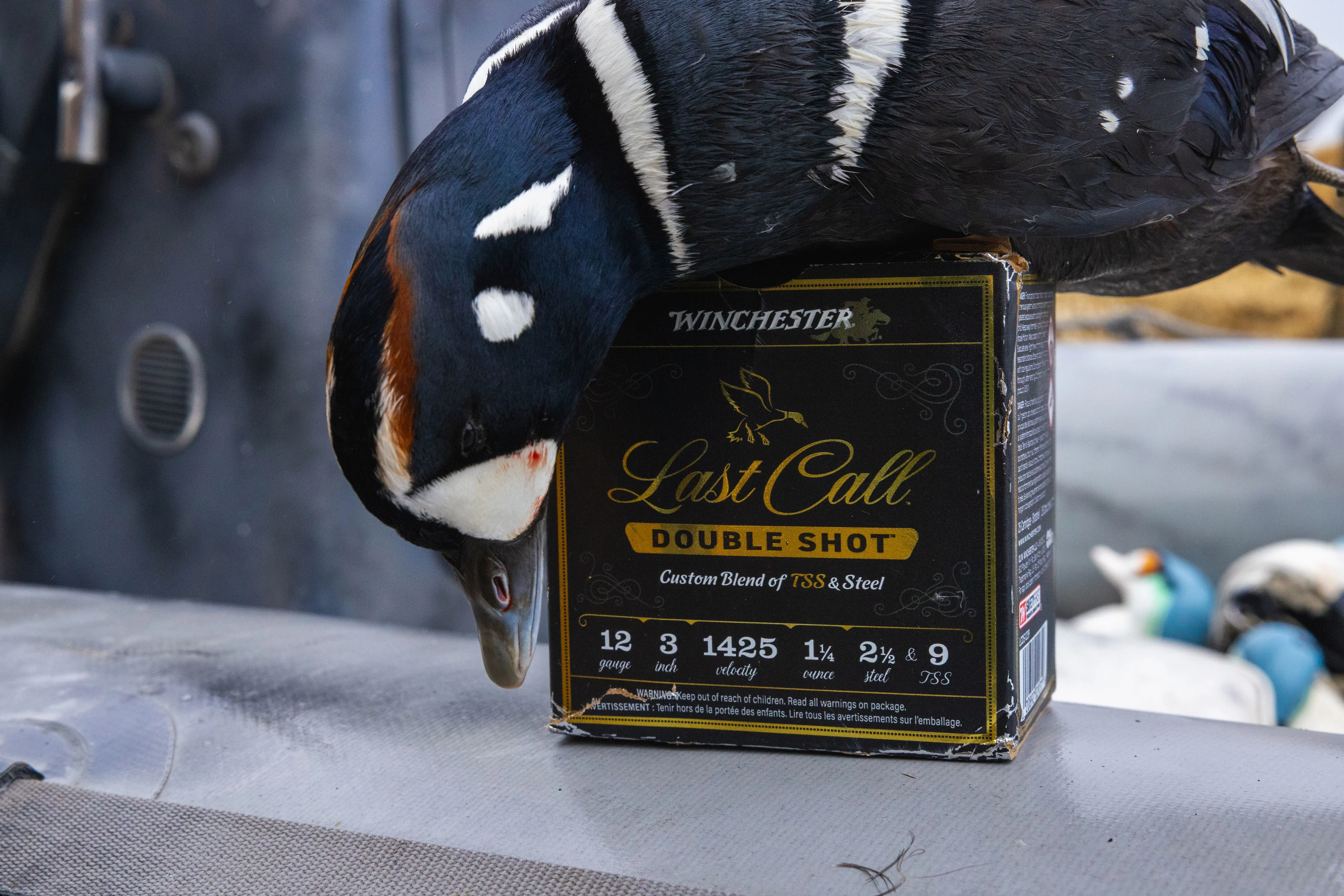
Most Innovative: Boss Copper 3/5
Specs
Gauges: 3-inch 12-gauge, 16-gaunge, 3-inch 20-gauge, 2 ¾-inch 28-gauge, 3-inch .410
Material: Corrosion-inhibited copper
Payloads: 1 1/2-ounce (3-inch 12-gauge), 1 1/4-ounce (2 ¾-inch 12-gauge), 1 1/8-ounce (16-gauge) 1 1/8-ounce (3-inch 20-gauge), 7/8-ounce ( 2 ¾-inch 28-gauge), ½-ounce (3-inch .410)
Velocity: 1350 fps (12-16-, 20- and 28-gauges), 1325 (.410 bore)
Shot sizes: 3, 5, or 3/5 blend (12- and 20-gauge), 3/5 or 5 (16-, 28-gaug,e and .410)
Load tested: 3-inch 12-gauge 1 ½ ounce 3/5
Price: $39/20-$40/20
Boss, having made its name with bismuth shotshells, pivoted to copper this year as the price of raw bismuth rose out of sight. The new pellets are corrosion-inhibited copper, which is listed as non-toxic by the USFWS. “Corrosion-inhibited” refers to fluorescent powder coatings detectable by ultraviolet light.
At 8.9 grams per cubic centimeter, copper is denser than steel (7.8 g/cc) and not quite as dense as bismuth (9.6 g/cc). Copper has a relatively low Brinell hardness number of 35 (bismuth is 18, steel is 136), making it safe for older gun barrels. The pellets are hard enough to remain round and resist deformation in the barrel, unlike bismuth, which needs a buffer to perform at its best. European makers have offered copper pellets for a few years now, and Winchester experimented with them years ago. Boss is the first to offer it to the US market. Like all Boss ammo, it is only available directly from Boss.
My test loads consisted of 1 ½-ounce 3/5 blended pellets loaded into a 3-inch hull. The pellets were round, but had some marks on them from manufacturing. The one-piece wad is plastic treated to degrade in the environment. Patterns at 40 yards through the RR 3 choke ran around 65 percent, which is Improved-Modified performance, although well below what this choke usually delivers with steel. But, there are enough pellets in 1 ½ ounces of 3/5s that I was getting 150-160 hits in a 30-inch circle, which is more than enough pattern density for any duck.
Boss copper shows real potential. I am guessing you can shoot one size smaller than steel and expect similar results, so anything you can do with a steel 2—which is a lot—you should be able to do with a Boss copper 3. And, based on the patterns I shot, you don’t need an entire ounce-and-a-half, so these should make viable smallbore pellets, too. Personally, I am looking forward to trying these in the 3-inch Model 12 I never get around to shooting during the season.
Best Budget: Remington Duck Club Steel
Specs
Gauges: 3 1/2-inch, 3-inch and 2 ¾-inch 12-gauge, 3-inch 20-gauge and 3 ½-inch 12 gauge
Material: Steel
Payloads: 1 3/8 ounces (3 ½-inch 12-gauge), 1 1/4 ounces (3-inch 12-gauge), 1 1/8 ounces (2 ¾-inch 12-gauge), 1 ounce (3-inch 20-gauge)
Velocity: 1500 fps (3 ½-inch 12-gauge), 1400 fps (3-inch 12-gauge), 1375 fps (2 ¾-inch 12-gauge), 1300 fps (3-inch 20-gauge)
Shot sizes: BB, 2,3,4 (3½-inch and 3-inch 12-gauge) 3,4 shot (2 ¾-inch 12-gauge, 3-inch 20-gauge)
Load tested: 3-inch 12-gauge 2
Price: $22.99-$30.99 per 25
I was in a café in Stuttgart, Arkansas, years ago, after a timber hunt with the CEO of a company that made premium non-toxic shot. He was going on about how the high price of his ammo was just a small part of any duck hunter’s budget, and how most people don’t shoot many shells in a season anyway, so the difference in overall cost was negligible. He then made the mistake of turning to our guide and asking, “How many shells do you shoot in a season?”
Kenny figured in his head for a moment, then said, “About seven cases.” If that’s you, then Duck Club Steel is worth a look.
Duck Club steel is Remington’s affordable steel shell, taking the place in the lineup of the now-discontinued Sportsman Steel. It’s been updated, too, with new powders and primers. Duck Club comes in all sizes of 12-gauge, plus in 3-inch 20-gauge. The 12-gauge hulls are black, the 20s are yellow, and if you’re looking for frills, you’ve picked the wrong box of shotgun shells. The stamping on my sample 12-gauge hulls was faint right out of the box. The primers were sealed, though. And, while unplated and plain, the steel 2 shot in my sample shells was round and uniformly sized.
The 3-inch 12-gauge loads have a muzzle velocity of 1400 fps, which is fast enough without producing the undue recoil of a higher-velocity load. Patterns through my IM/RR 3 choke averaged 70 percent at 40 yards. This is not earthshaking pattern-performance, but it’s not underperforming, either. If I burned through shells by the case and wanted to keep ammo cost under control, I would shoot these with total confidence.
Federal Ultra-Steel Double Stack
Specs
Gauges: 31/2-inch 10 and 3 ½-inch 12 gauge
Material: Steel
Payloads: 1 5/8 ounces (10-gauge), 1 1/2 ounces (3 ½-inch 12-gauge)
Velocity: 1400 fps (10-gauge) 1500 fps (20-gauge)
Shot sizes: BBBx1, BBx2 (10-gauge) BBx2, 2x4 3 ½-inch 12-gauge
Load tested: 10-gauge BBBx1
Price: 49.99-$57.99 per 25
Federal extended its UltraSteel Double Stack lineup this year, and finally, the big guns get some love. New loads for the almost-forgotten 10-gauge and the 3 ½-inch 12 should find a receptive audience now that the high price of bismuth is cooling the smallbore trend. It may be time to put down that new 3-inch 28-gauge and take another look at that big bore gathering dust at the back of the safe.
I cleaned the cobwebs off my Browning Gold 10 to pattern the BBBx1 load. First, though, I cut one of the brown hulls open and examined the pellets. The BBB pellets were on top, and there was a full ounce of the big shot stacked on top of 5/8-ounce of 1s. Usually, in stacked loads, the smaller pellet payloads outweigh the big ones. Not here. You get a full ounce of big pellets, backed up by 5/8 ounces of 1 shot, and that works out to about 62 or so of each, all loaded into Federal’s rear-braking FliteControl Flex wad.
Under the assumption that overchoking the large BBBs might prove counterproductive, I tried this with a Rob Roberts RR2—about a Light Modified—at first. Patterns averaged 70 percent, which is good performance and resulted in about 90 hits in a 30-inch circle. That’s more than enough for a goose, especially when the BBBs were well-represented in the middle of the pattern. Under the counter-assumption that I could be wrong about the over-choking, I tried the RR 3 (Improved Modified, give or take) and was rewarded with frightening 82 percent patterns.
Winchester Final Pass
Specs
Gauges: 3 ½-inch 12-gauge, 3-inch 12-gauge, 3-inch 20-gauge
Material: Steel
Payloads: 1 ½-ounces (3 ½-inch 12-gauge), 1 ¼ ounces (3-inch 12-gauge) 1 ounce (3-inch 20-gauge)
Velocity: 1400 fps (12-gauge) 1300 fps (20-gauge)
Shot sizes: BBx1 ½ (3 ½- and 3-inch 12) 2 ½ x4 (3-inch 12-gauge, 3-inch 20-gauge)
Load tested: 3-inch 12-gauge 2 ½ x4
Price: $ 32.64 per 25
Not content to offer a stacked load just like the one everyone else makes, Winchester came up with new shot sizes—1 ½ and 2 ½—to combine with standard 4 shot. My sample loads were 2 ½ x 4, so I took the opportunity to count and weigh the size 2 ½ pellets. Weighing an average of 3.2 grains (vs 3.5 for a standard 2), 2 ½ pellets give you 137 per ounce, vs 125 2s. So you get 12 more pellets per ounce with almost the same energy.
The shot is loaded in a two-piece shotcup/overpowder seal arrangement, with a lacquer seal around the primer. In most duplex loads, the large pellets are stacked atop the smaller ones. Here, they are mixed together. Winchester engineers found that with two pellets fairly close in size, there is no need to separate them.
Based on the pattern board result, Winchester engineers are pretty smart. These gave me good 75 percent patterns from an RR 3, which translates into about 160 hits in a 30-inch circle. That makes these a load dense enough even for small ducks like teal. It would be great for wood ducks and, I’d predict, potent enough for big ducks over decoys, too.
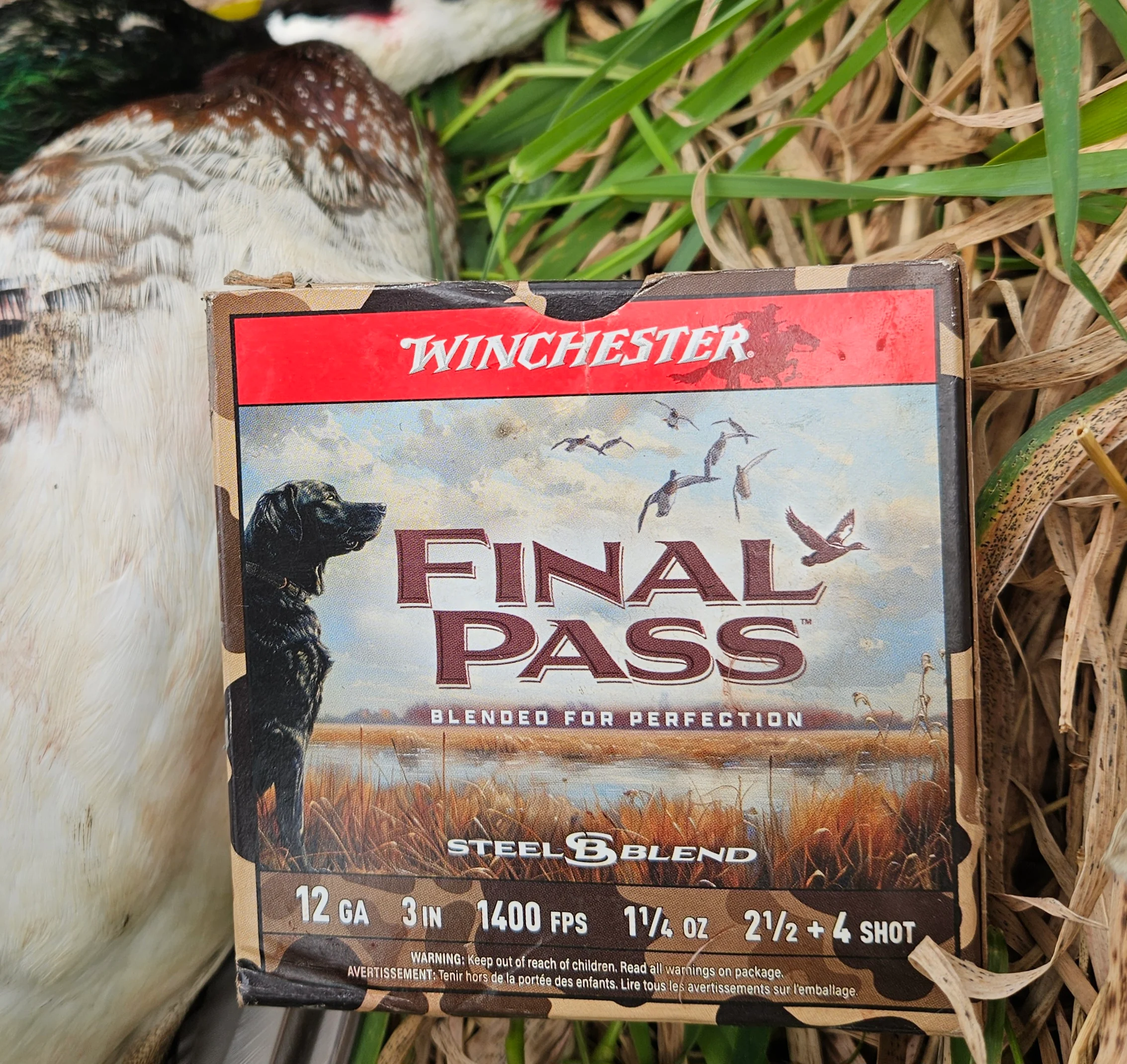
HeviShot HeviHitter
Specs
Gauges: 3-inch 12-gauge, 16-gauge, 3-inch 20-gauge, 3-inch 20-gauge
Material: HeviShot and Steel
Payloads: 1 1/4-ounces (3-inch 12-gauge), 1 ounce (16-gauge), 7/8 ounce (3-inch 20-gauge), ¾-ounce (3-inch 28-gauge)
Velocity: 1500 fps (12-gauge), 1350 fps (16-gauge), 1450 fps (20-gauge), 1450 fps (28-gauge)
Shot sizes: BB/BB, 2/2, 3/3. 4/4 (3-inch 12) 2/2, 4/4(16-gauge) 2/2, 3/3, 4/4 (3-inch 20-gauge) 2/2, 4/4 (3-inch 28-gauge)
Load tested: 3-inch 12-gauge 2/2
Price: $48.99-$49.99 per 25
Up until now, the usual mixed stacked load combined a larger size of steel with a smaller size of bismuth, tungsten-iron, or TSS. Often, the two pellets were chosen because they have similar energy levels. The role of the smaller shot is to increase the overall pellet count and add some extra energy. The steel was there to fill the pattern and keep the price down.
HeviHitter instead matches two different materials—steel and HeviShot—of the same pellet size. You give up pellet count, but you gain in energy. Compared to any steel pellet, a HeviShot pellet of the same size is a wrecking ball, carrying twice as much energy downrange as the steel pellet.
My sample 2/2 shell was loaded in the traditional Hevishot light-brown/tan hull, with a pinch of flax-seed filler on top, as is also typical of Hevishot ammo. The HeviShot pellets were fairly true to size, which hasn’t always been the case with HeviShot, although they retained the little bulges and goiters, and two were stuck together. I counted 21 HeviShot pellets and 116 steel 2 pellets loaded into a one-piece wad. By comparison, a straight 1 ¼-ounce load of steel 2s contains 156 pellets, so you’re losing about 20 pellets overall by using the HeviShot in place of all steel.
I weighed the steel and HeviShot pellets, too. The steel pellets averaged 3.5 grains, as they should. The Hevishot averaged around 6 grains, give or take. That weight confirmed that these are the original, 12-gram/cubic centimeter original HeviShot, not the watered-down pellets sold at times in the past.
Shot through the RR 3 choke I used throughout this test, the HeviHitter put 96 pellets into a 30-inch circle at 40 yards. This is enough for big ducks, and definitely enough for geese. Given that both pellets were the same size, I couldn’t tell where the Hevishot pellets were landing in the pattern. To find out, I shot five 9x12 paperback phone books at 35 yards through the RR3/IM choke. Every shot hit the books with at least 25 pellets. Anywhere from 1 to 4 of those hits were a HeviShot pellet. So the odds are pretty good, but not 100 percent that you’ll put 1 or 2 HeviShot pellets into a goose-sized bird with the 2/2 load. Sometimes it might be more, sometimes it might be none. The only way to find out if these work for you is to pick up a box or two.
Apex S3 Steel/TSS 3x8 Mossy Oak ShadowGrass Blend
Specs
Gauges: 3-inch 12-gauge,3-inch 20-gauge
Material: Steel and TSS blend
Payloads: 1 5/16-ounce (3-inch 12-gauge), 1 1/8-ounce (3-inch 20-gauge
Velocity: 1400 fps (12-gauge) 1250 fps (20-gauge)
Shot sizes: 3 steel, 8 TSS
Load tested: 20-gauge
Price: $54.99 per 25
Apex, the first maker to offer factory TSS ammo, builds on its lineup of S3 steel/TSS ammo with the Mossy Oak ShadowGrass Blend. Does it sway me that the boxes are printed in my all-time favorite camo pattern? The answer is no, of course, but the boxes are great-looking. Nevertheless, we’re on the hunt for inner beauty here. What’s inside these shells is a mix of very pretty, shiny, round steel 3 shot layered on top of a thimble-full of precious TSS 8s.
The 20-gauge shells I tested are loaded with ¼ ounce of TSS and 7/8-ounce steel, while the 12-gauge holds 1 1/16 ounces of steel on top of a ¼ ounce of TSS. Since my sample loads were 20-gauge shells and because I don't have a choke tighter than Modified for my 20-gauge semiauto, I decided to give them a break and shoot them at 35 yards instead of the standard 40. This was perhaps condescending of me. At 35 yards with a Modified, the Shadowgrass Blend printed dense patterns dense enough that a teal flying sideways wouldn’t be able to get through unscathed. After counting up holes big and small and doing the math, it worked out to 82 percent patterns, which was very strong performance.
The TSS pellets were generally well-distributed through the pattern, with the exception of one odd pattern where most of the TSS wound up in the upper-right quadrant, although there were still plenty of pellets spread across the circle to reliably kill a duck. These shells will absolutely add punch to your 20.
The 12-gauge shell has a heavier payload, but since all the extra pellets are steel, you only get about 25 more steel 3s per load. The 12 is much faster, at 1400 fps vs the 1250 fps of the 20. Still, of the two, I like the 20, and would shoot any decoying duck with it.
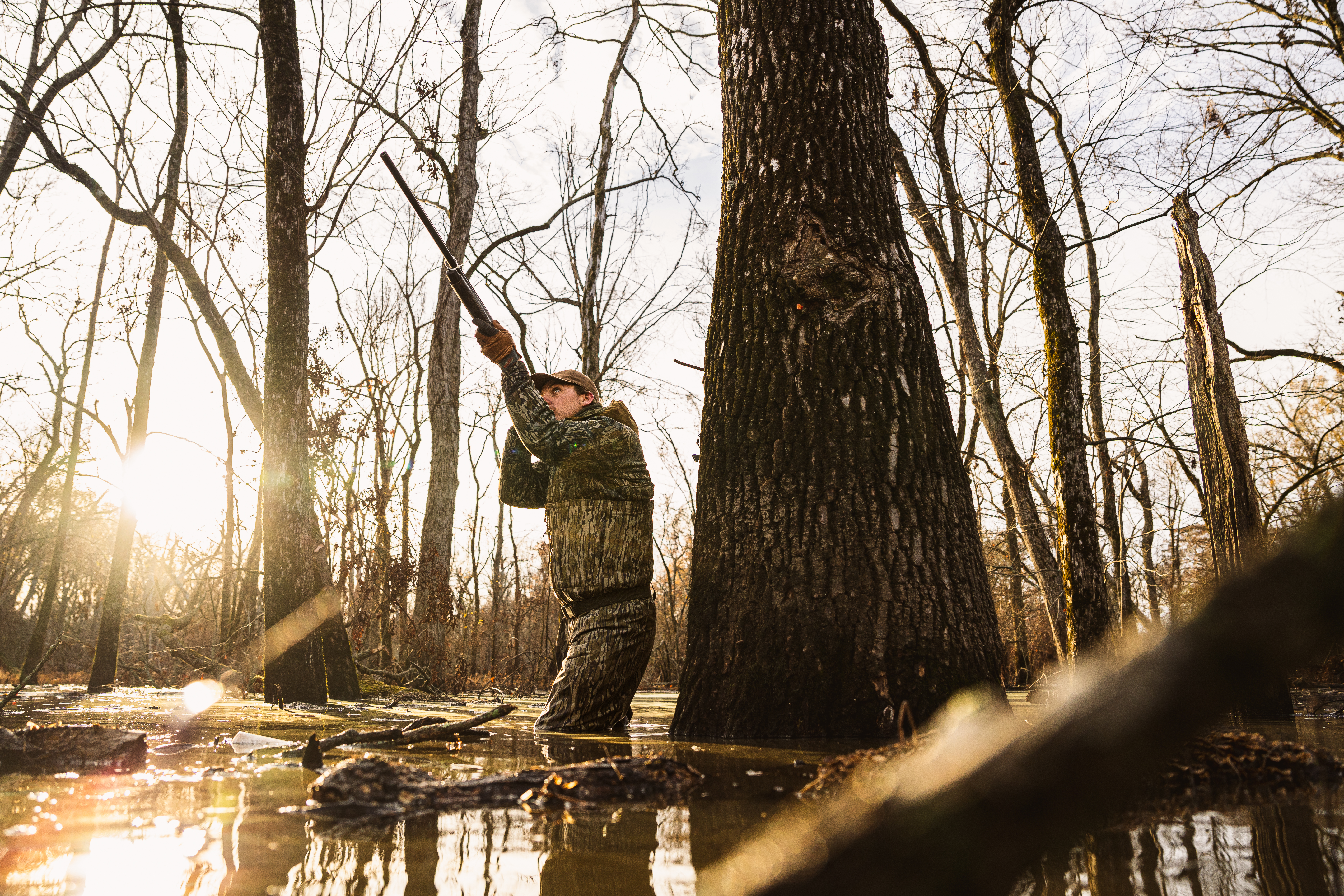
Things to Consider When Buying Waterfowl Ammo
A shotshell is only one part of a system made up of the shell, the gun, and the choke. You need to choose choke/load combinations that will perform best for the type of shooting you do with your shotgun. Pattern-testing your gun is the way to learn what it does at various ranges. Shoot a big sheet of paper, then draw a 30-inch circle with the densest part of the pattern at the center. Check to be sure the pellets are spread fairly evenly across the circle. A good pattern will be denser in the center and more open at the fringes, but not so dense that it tears up birds and is easy to miss because it’s so small. Shoot at the range you expect to shoot in the field. Shoot at least three patterns at each distance with each choke/load combination, although shooting five patterns is better, and ten gives you the clearest idea of what’s going on. There can be lots of variability from shot to shot.
In general, you should choose very open chokes for TSS, which typically are small, hard, tight-patterning pellets. Improved Cylinder is a good place to start testing TSS loads. Likewise, Hevishot HeviXII is known to pattern efficiently, so start with open constrictions there, too. For steel, usually, a Light Modified or Modified choke is a good choice for over-decoy shooting, and an Improved Modified is best at longer ranges. Bismuth, unless it’s buffered like Winchester or Boss War Chief, often patterns inefficiently because the load loses pellets to shattering. Pick a tighter choke to compensate, such as Modified for close range or Improved Modified.

FAQs
Q: Is 2 or 3 shot better for ducks?
Both 2 and 3 shot are effective pellet sizes for ducks when you’re using steel shot. Three shot has a higher pellet count per ounce (153 for 3s vs 124 for 2s), so it can put more hits on target. On the other hand, 2 shot will have more energy. My advice is to shoot 3s for ducks over decoys if there is no chance of geese, and pick 2s if Canadas, snows, or specks might visit your spot.
Q: What is the best load for shooting ducks?
The best load for shooting ducks combines adequate pellet numbers and energy to put enough lethal hits on a duck and also has manageable recoil so you can shoot it effectively. If money is no object, TSS or Tungsten-Iron HeviXII are the best loads because they are very dense and retain a lot of energy, even in small pellet sizes that give you high pellet counts. In steel shot, a 12-gauge, 1 ¼-ounce load of 2 or 3 shot for big ducks like mallards or 4 shot for wood ducks and teal is usually best and also most cost-effective.
Q: What is the best shot weight for duck hunting?
Assuming “shot weight” means the weight of the payload in the shell, it varies by pellet material. In steel, loads of 1 1/8-ounce to 1 1/4-ounce comprise enough pellets of the appropriate size to do the job. Loads with 1-ounce to 1 ¼-ounces of bismuth or tungsten-iron shot are a good weight range, and in TSS, you can go down to 7/8 ounce or even 1/2 -ounce because those very dense pellets allow you to choose small shot sizes so you get plenty of pellets plus plenty of energy.
Q: What gauge is best for duck hunting?
The 12-gauge remains the standard duck gun, as it should. It’s the most versatile gauge in terms of the range of loads you can find for it. Also, it’s the best choice if you want to keep costs down and shoot steel pellets because the 12-gauge hull has the large capacity needed to hold adequate amounts of big steel shot. Some disagree, but I don’t think 3 1/2-inch shells are necessary for ducks. A 3-inch shell holds enough shot and 3 ½-inch shells kick hard.
Smaller gauges, 20- and 28-gauge, are currently popular. They make good waterfowl guns, although their smaller hulls work best with denser pellets like bismuth, HeviXII, and TSS, where you can choose smaller pellets and fit enough in the hull to produce adequately dense patterns. If you shoot steel in a 20-gauge, your range will be limited both because pellet counts are lower and because 20-gauge hulls can’t contain adequate payloads of bulky pellets like BBs.

